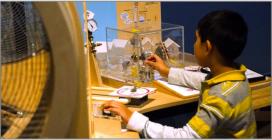Science Museum of Minnesota Attracts Interest in Fluid Power Research through Playful Interactive Exhibits
The Center for Compact and Efficient Fluid Power (CCEFP) at the University of Minnesota – a graduated Engineering Research Center (ERC) sponsored by the National Science Foundation (NSF)—continues to partner with the Science Museum of Minnesota (SMM) to develop engaging interactive science exhibits that teach the public about fluid power innovations.
CCEFP’s partnership with SMM helps educate adults and families about the basics of fluid power while introducing some of the research carried out in CCEFP’s research programs. Prototypes and exhibits are jointly developed through a range of Center partnerships and serve as models for dissemination to other science museums and educators around the world. Public audiences also benefit from learning about future industrial and social applications of fluid power.
The fluid power exhibit collaborations between CCEFP and SMM began in 2007, with small teams of senior students at the University of Minnesota developing interactive fluid power prototype demos as part of their Capstone Projects. Soon after, an Eden Prairie high school student worked with CCEFP to develop a hydraulic hybrid Supermileage Car that achieved 160 miles per gallon (mpg) in tests on a raceway in Brainerd, Minnesota. The car went on display in SMM’s Experiment Gallery, which quickly became a popular home for other fluid powered inventions.
As the exhibits continued attract interest, SMM joined CCEFP as an affiliated partner organization, jointly developing and extensively field-testing a wide range of new prototypes for exhibit. One example includes an immersive Hydraulics Lab experience; visitors are challenged to create hydraulic circuits that will ring a large bell and operate a carousel powered by a Pelton wheel. Another created by the student team shows how wind energy can be stored through compressing air into an open accumulator.
The exhibits highlight newly accessible applications for fluid power that address high-profile physical, social, and economic problems. With a focus on experiential learning, the open-ended design allows visitors to engage longer and more deeply in investigation and experimenting. CCEFP industry partners have also found opportunities for involvement, occasionally donating hard-to find, off-the-shelf hardware of appropriate size for use in museum settings.


